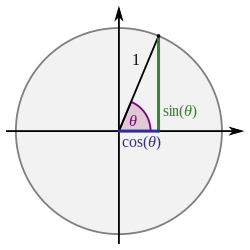
Back Sinussatz ALS قانون الجيب Arabic Sinuslar teoremi Azerbaijani Тэарэма сінусаў Byelorussian Синусова теорема Bulgarian সাইন নিয়ম Bengali/Bangla Sinusna teorema BS Teorema del sinus Catalan یاسای ساینەکان CKB Sinová věta Czech
| Trigonometry |
|---|
 |
| Reference |
| Laws and theorems |
| Calculus |
| Mathematicians |
In trigonometry, the law of sines, sine law, sine formula, or sine rule is an equation relating the lengths of the sides of any triangle to the sines of its angles. According to the law, where a, b, and c are the lengths of the sides of a triangle, and α, β, and γ are the opposite angles (see figure 2), while R is the radius of the triangle's circumcircle. When the last part of the equation is not used, the law is sometimes stated using the reciprocals; The law of sines can be used to compute the remaining sides of a triangle when two angles and a side are known—a technique known as triangulation. It can also be used when two sides and one of the non-enclosed angles are known. In some such cases, the triangle is not uniquely determined by this data (called the ambiguous case) and the technique gives two possible values for the enclosed angle.
The law of sines is one of two trigonometric equations commonly applied to find lengths and angles in scalene triangles, with the other being the law of cosines.
The law of sines can be generalized to higher dimensions on surfaces with constant curvature.[1]
- ^ "Generalized law of sines". mathworld.



